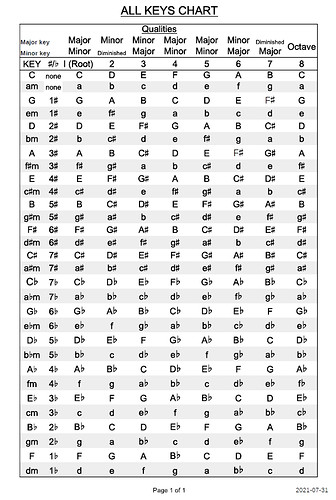thank you from saving me all the effort ![]()
You pretty much only need to learn 2 scales, major and minor in 3 positions each and 4 arpeggio (chord) shapes: Major 7, Minor 7, Dominant 7, Minor 7 flat 5. Then it’s pretty easy to learn the modes after that… you already know Ionian and Aeolian, Phrygian and Lydian are the same except for 1 note. As you noted, it’s the tonal relationship that’s really important and I think it’s much easier to learn the sound of the modes than it is to learn the formulas for them ![]()
So, are you saying the A minor, in Josh’s example shows BOTH A minor scale and A melodic Minor, meaning, you could use one or the other anytime you are in that key?
Very interesting stuff for sure, we appreciate the TED talks from you every time.
I find modes easy, it’s all the keys and subsequent minors that I have more trouble with.
The chords above that @GanglyCloth posted show the A natural minor scale and the A harmonic minor scale. There is no hint of the A melodic minor scale (which would have an F# in it).
In general, the notes of the natural minor are what are used as the functional notes and harmony for songs in a minor key - particularly pop songs. The adjustment of adding notes outside the key signature (in the case of the example, the G#) would only happen when the chord/harmony called for it.
Keys are helpful in the macro view, and they are helpful in talking about chord progressions and relationships. But in the trenches of playing a song, it is much more accurate and helpful to play to the specific harmony at any given moment.
The melodic minor is a slippery fish and has all kinds of influence and use in jazz and extended harmonies - but it is very very rarely found in any pop music.
Harmonic minor is rarely used as a scale - it is named as such because the only note that changes (compared to the natural minor) is changed at very specific times only in the music and only to adjust the harmony of the V chord to make it lead towards the minor tonic chord.
Wow. I need a Twitter-like word limit on this.
All I mean to say @T_dub is that you can only use Harmonic Minor or Melodic Minor when the harmony of the music specifically brings in those altered notes.
Damn.
Hope something up there makes sense.
Don’t think that would work trying to explaining things like this in music theorys. Something would get left out and that is not a good thing. You did a great job here.
Thank you for this explanation, and history lesson, re. the reasoning behind the Harmonic Minor and Melodic Minor scales @Gio. I enjoyed it.
It all makes sense.
One of the things about putting a chart like this together is that it is hard to get it 100% correct the first time, especially if you try and do it in one sitting. 
I just noticed that the f in the a♭m key was listed as f♮ when it should be f♭
I am not surprised that nobody spotted it because with our instruments who plays music written with 7♭’s
I corrected the original post to reflect the change and also included it here for convenience.
*** Also edited to add Major and minor key qualities.
Thank you so much for this! Very helpful 
You are more than welcome.
You may find the Circle of Fifths/Fourths charts I have posted on the forum lot more useful. There is a lot more information on them. Here is one of the last ones I posted.
Circle.pdf (528.3 KB)
Here is a great video about the simplicity of music theory that may interest you.
Also thank you!  I’ll check out the video
I’ll check out the video

